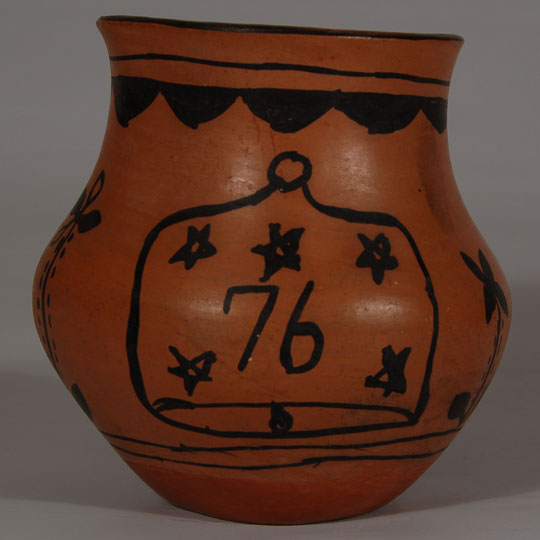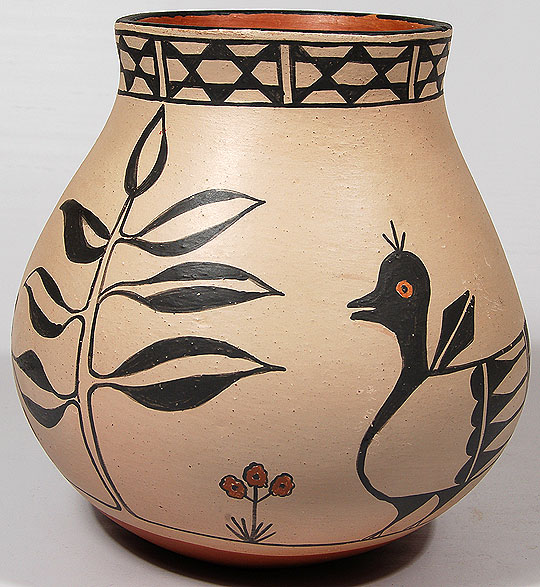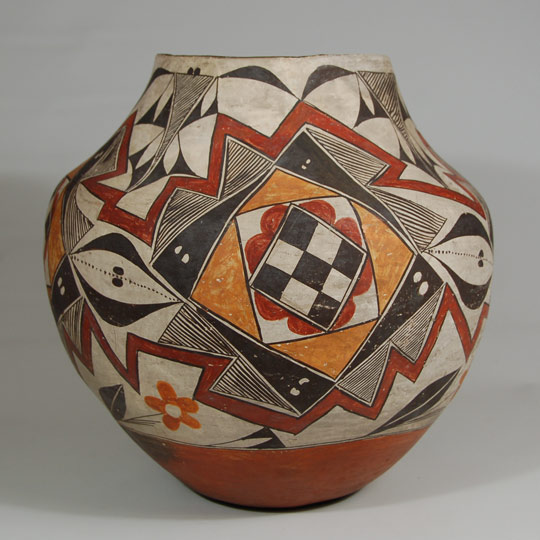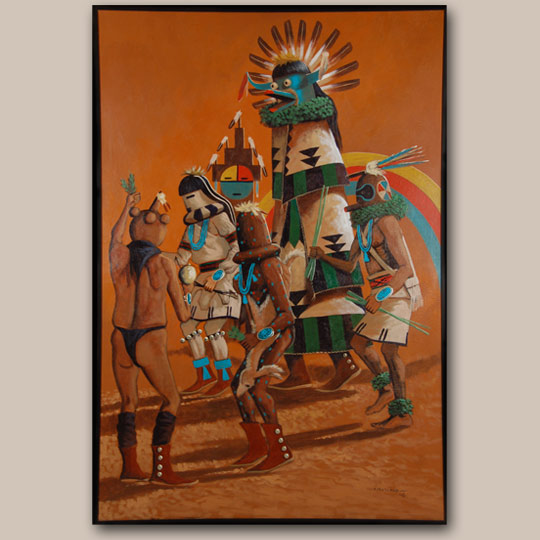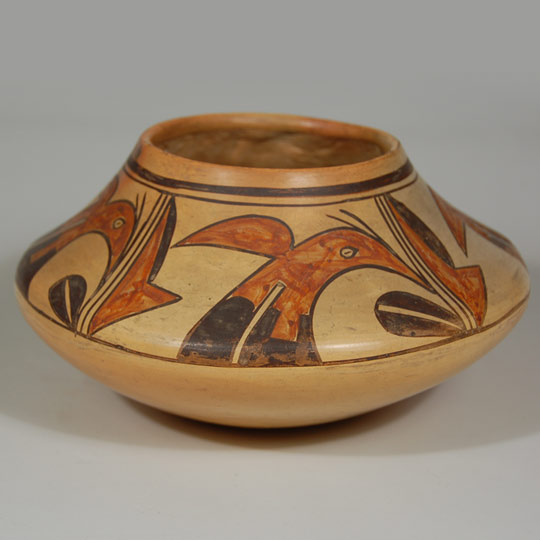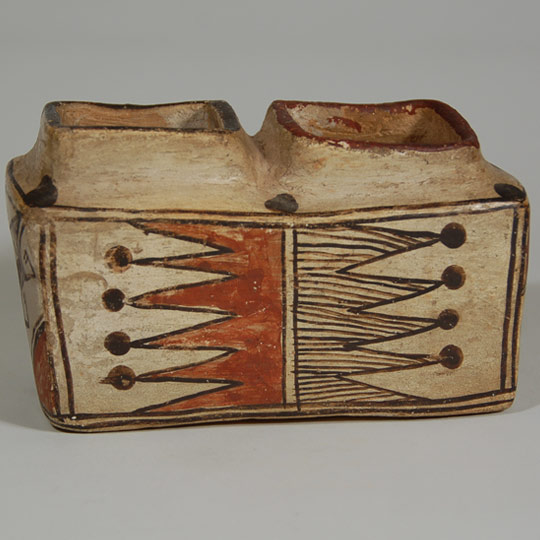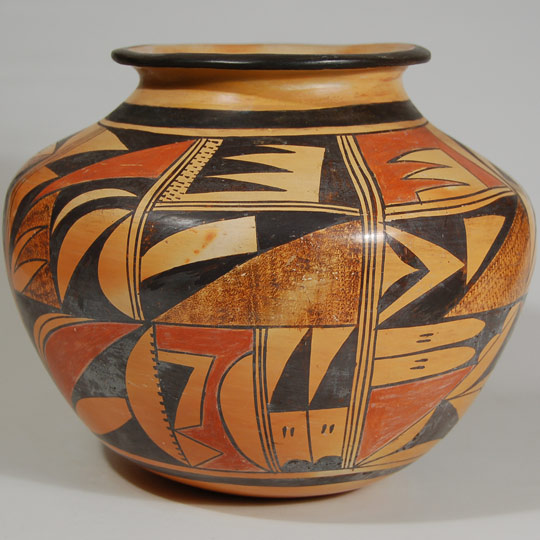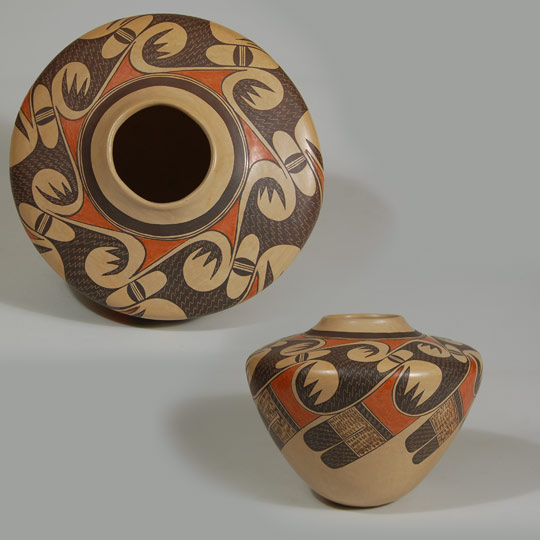Subject: Acoma Pueblo Polychrome Jar with Zuni Designs
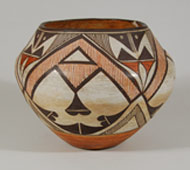 Designs on pueblo pottery were influenced by many outside sources starting as early at the mid-1800s. Floral elements, birds, deer, and other designs could easily have been influenced by Spanish colcha designs as well as pottery designs from Mexico. It was also evident that potters borrowed designs from pueblos other than their own.
Designs on pueblo pottery were influenced by many outside sources starting as early at the mid-1800s. Floral elements, birds, deer, and other designs could easily have been influenced by Spanish colcha designs as well as pottery designs from Mexico. It was also evident that potters borrowed designs from pueblos other than their own.
The heartline deer design was first seen at Zuni Pueblo, but later appeared on pottery from Acoma, Laguna and Zia Pueblos. Intermarriage between pueblos also contributed to designs appearing where they never appeared before.
This Acoma jar is completely covered with Zuni design elements. The orange/red fine lines in the A-frame areas are most typically Zuni in origin. The entire layout of the design is typical of Zuni arrangement, yet the pot is from Acoma Pueblo. It is not as thin-walled as Acoma pottery generally is so it is possible that a transplant potter from Zuni or another pueblo moved to Acoma and practiced the art of making Acoma pottery but had not yet achieved the expertise of creating thin walls.
The jar is a beautiful example of a well formed vessel and a beautifully arranged design. It is in excellent condition.
Subject: Acoma Pueblo Polychrome Jar with Zuni Designs
Potter Unknown
Category: Contemporary
Origin: Acoma Pueblo
Medium: Native Materials
Size: 6-3/4" tall x 9" diameter
Item # C3064B
Subject: Hopi Pueblo Flat Top Polychrome Seed Jar by Helen Naha
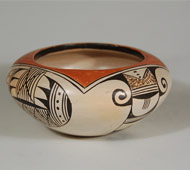 Helen Naha (Feather Woman) and Joy Navasie (Frog Woman) were sisters-in-law. Helen Naha married Joy Navasie's brother, Archie Naha. Helen was known for her stark black-on-white Hopi pottery early in her career and for exquisite polychrome pots in later times. Her hallmark is a feather.
Helen Naha (Feather Woman) and Joy Navasie (Frog Woman) were sisters-in-law. Helen Naha married Joy Navasie's brother, Archie Naha. Helen was known for her stark black-on-white Hopi pottery early in her career and for exquisite polychrome pots in later times. Her hallmark is a feather.
This wonderful wide and low jar is slipped in traditional white slip, over which is painted the decoration in deep dark brown. The design is often referred to as a "bear claw." The round opening at the top of the jar has been outlined in a square orange slip which was then outlined in a pair of black lines. The designs on the four sides of the jar are pendant from the outer black rim line.
Condition: The jar is structurally in excellent condition. There is some slip loss near the feather hallmark on the underside but nothing truly significant.
Provenance: from the collection of an elderly Santa Fean
Recommended Reading: Hopi-Tewa Pottery: 500 Artist Biographies by Gregory and Angie Schaaf
Subject: Hopi Pueblo Flat Top Polychrome Seed Jar by Helen Naha
Artist / Potter: Helen Naha [1922-1993] Feather Woman
Category: Contemporary
Origin: Hopi Pueblo
Medium: clay, pigment
Size: 2-7/8" tall x 5-3/4" diameter
Item # C3391
Subject: Laguna Pueblo Exquisite Pottery Polychrome Canteen
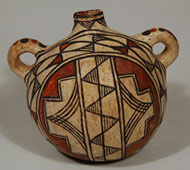 This is one of the most strikingly beautiful Laguna Pueblo canteens we have acquired in over a decade. Not only does it have a bulbous front, it has a bulbous back as well. The vessel sits on its base so that the design is easily visible.
This is one of the most strikingly beautiful Laguna Pueblo canteens we have acquired in over a decade. Not only does it have a bulbous front, it has a bulbous back as well. The vessel sits on its base so that the design is easily visible.
The canteen was slipped in creamy white clay, polished to a smooth finish and that then became the canvas on which the artist began to execute her design. A circle outlined with a pair of thin black framing lines set the stage for the main body design which was then divided into a pair of semicircles split by a rectangular bar. The bar was divided by a single black line down its middle from which black triangles are pendant and their directions are alternate. The triangles were then filled with fine black lines.
The semicircles on the body were each designed with a stepped element inside which is a triangle formed with four black lines intersecting at an apex. The area between the stepped elements was filled in with red. A wide band encircles the main body design and it contains a chain of triangles, some of which are filled in with red and alternating ones filled in with fine lines.
The back of the canteen is designed with a solid red center bordered by triangles of fine line elements that alternate directions. The neck repeats such triangles, all of which are pendant from a framing line. The rim is painted black, the interior of the rim painted red and alternating black and red dots adhere to the handles. The canteen dates to the first quarter of the 20th century, probably circa 1920.
Condition: structurally in excellent condition with excellent condition of the painted design.
Provenance: from an elderly lady in Santa Fe
Recommended Reading: Acoma and Laguna Pottery by Rick Dillingham
Subject: Laguna Pueblo Exquisite Pottery Polychrome Canteen
Unknown Maker
Category: Historic
Origin: Laguna Pueblo
Medium: clay, pigment
Size: 6" tall x 6-3/4" wide x 4-1/2" deep
Item # C3389
Subject: Original Painting of a Panel from a Church Altar Screen
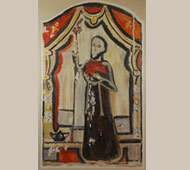 The prosperity of the 1920s ended with the economic catastrophe known as the Great Depression. By 1933 industrial production had fallen, thousands of banks were closed, and millions of Americans were jobless. President Franklin D. Roosevelt's "New Deal" aimed at promoting economic recovery and putting Americans back to work through Federal jobs programs for the unemployed. Establishing the foundation of the modern welfare state while preserving the capitalist system, the New Deal experimented with unprecedented activism in an attempt to relieve the social and economic dislocation experienced by much of the nation. Federal programs extended not only into American business, agriculture, labor, and the arts, but into people's daily lives. Despite a mixed legacy with respect to recovery and reform, the political response under Roosevelt proved that economic crisis did not require Americans to abandon democracy.
The prosperity of the 1920s ended with the economic catastrophe known as the Great Depression. By 1933 industrial production had fallen, thousands of banks were closed, and millions of Americans were jobless. President Franklin D. Roosevelt's "New Deal" aimed at promoting economic recovery and putting Americans back to work through Federal jobs programs for the unemployed. Establishing the foundation of the modern welfare state while preserving the capitalist system, the New Deal experimented with unprecedented activism in an attempt to relieve the social and economic dislocation experienced by much of the nation. Federal programs extended not only into American business, agriculture, labor, and the arts, but into people's daily lives. Despite a mixed legacy with respect to recovery and reform, the political response under Roosevelt proved that economic crisis did not require Americans to abandon democracy.
New Mexico was among the poorest states in the Union in the 1920s and it went from bad to worse with the onset of the Depression. The New Deal programs administered throughout the country were especially needed in New Mexico and particularly in rural villages. Perhaps the best known of the back-to-work projects was New Mexico's various arts and crafts projects. The most ambitious of these in New Mexico was the Federal Art Project (FAP) under the direction of Russell Vernon Hunter. Just one year after the start of the program, some 40,000 WPA artists and other cultural workers were employed in projects throughout the United States.
In New Mexico, Hunter supported regional and cultural artistic expression and was lucky to have had both native and established East Coast artists. The various art projects had at their core in New Mexico altruistic efforts to record and preserve traditional native, be it Native American or Hispano, cultural production. Many murals were painted in public buildings in New Mexico and many church altars were copied as a means of preserving them for the future.
This painting of a panel from a New Mexico church altar is typical of some of the activities promoted and was quite likely made by a New Mexican by the name of Jorge Sanchez of Albuquerque who is believed to have worked under the sponsorship of artist Cady Wells. What appears to be damage on the painting is actually the true representation of the damaged altar panel that Sanchez copied. It appears that this is a watercolor, on paper, fixed to artist board. It unfortunately was not signed by the artist.
Condition: appears to be in original condition.
Provenance: from the collection of Katherine H. Rust of Albuquerque
References: The above information on the WPA in New Mexico is based on a published article by the New Mexico Office of the State Historian. The attribution of the work to Jorge Sanchez was from consultation with Santa Fe resident Elizabeth McGorty and gallery owner Nat Owens.
Subject: Original Painting of a Panel from a Church Altar Screen
Artist: Jorge Sanchez - Attribution
Category: Paintings
Origin: European-American Artists
Medium: watercolor on paper
Size: 39-1/2" x 24-1/2" image; 44-1/4" x 29-3/4" framed
Item # C3224AP
Subject: Kewa Pueblo Black-on-red Jar with an American Flag
Many Native artists contributed to celebrating the 200th anniversary of the United States by producing Navajo blankets, beadwork, basketry and pottery featuring an American flag or a reference to 1776. Santana Melchor (ca.1889-1978) and her granddaughter, Darlene (ca.1950s-), produced this Black-on-red jar featuring an American flag with 76 in the stars and 76 painted on the Liberty Bell. The artists co-signed the underside of the jar.
Santana Melchor was considered one of the finest potters at Santo Domingo in the early- and mid-20th century. She made exceptional large storage jars. Throughout her career, she used traditional designs and is responsible for keeping that tradition alive. She was part of the delegation of pueblo potters who visited the White House in 1974 as a guest of first lady Pat Nixon.
Condition: It is in original condition.
Provenance: from the collection of Katherine H. Rust
Recommended Reading: Southern Pueblo Pottery 2,000 Artist Biographies by Gregory Schaaf
Subject: Kewa Pueblo Black-on-red Jar with an American Flag
Artists / Potters: Santana Melchor (ca.1889-1978) and Darlene Melchor (ca.1950s-)
Category: Contemporary
Origin: Kewa Pueblo (Santo Domingo)
Medium: clay, pigment
Size: 5" tall x 5" diameter
Item # C3227.04
Subject: Kewa (Santo Domingo) Pueblo Polychrome Jar by Alvina Garcia
This absolutely wonderful jar by Alvina Garcia features two charming birds among flowers and foliage. The bentonite slip is smooth and creamy and the black designs are strong and bold. She placed the traditional "star" design around the neck of the jar and stone polished the red slip on the interior of the neck.
Condition: The jar is in original excellent condition
Provenance: ex. coll. Frances Sonnenberg, Santa Fe resident.
Subject: Kewa (Santo Domingo) Pueblo Polychrome Jar by Alvina Garcia
Artist / Potter: Alvina Garcia (1943-present)
Category: Contemporary
Origin: Kewa Pueblo (Santo Domingo)
Medium: Native materials
Size: 8-3/4" tall x 8-1/2" diameter
Item # C3148ZF
Subject: Cochiti Pueblo Pottery Canteen with Lizard Design
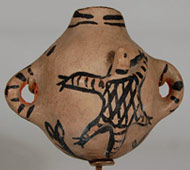 Cochiti Pueblo has a long history of producing figurative pottery. It reached its prime in the last quarter of the 19th century and the first quarter of the 20th century. There was a strong revival in the early 1970s with the production of storyteller figurines. Some potters at Cochiti expanded beyond the traditional storyteller figurines and made vessels of varying styles, vessels with figurines attached in bas relief, such as this wonderful pottery canteen with a lizard in relief.
Cochiti Pueblo has a long history of producing figurative pottery. It reached its prime in the last quarter of the 19th century and the first quarter of the 20th century. There was a strong revival in the early 1970s with the production of storyteller figurines. Some potters at Cochiti expanded beyond the traditional storyteller figurines and made vessels of varying styles, vessels with figurines attached in bas relief, such as this wonderful pottery canteen with a lizard in relief.
A metal stand has been specially fabricated for the canteen so that it sits with the spout turned upward to prevent water from pouring out. The lizard in bas relief is perched on top of the canteen as if heading for the spout to get a drink. The stand provides for a full view of the lizard.
The canteen is not signed by an artist. From the patina, it appears to be at least a half-century old.
Condition: very good condition
Provenance: from the collection of a Santa Fe resident
Recommended Reading: A River Apart: the Pottery of Cochiti and Santo Domingo Pueblos. Edited by Valerie K. Verzuh
Subject: Cochiti Pueblo Pottery Canteen with Lizard Design
Potter Unknown
Category: Contemporary
Origin: Cochiti Pueblo
Medium: clay, pigment, metal stand
Size: 4-1/2" tall x 5-3/8" wide x 4" deep
Item # C3364A
Subject: Magnificent Large Laguna Pueblo Four-color Polychrome Olla
A very old paper note inside this jar is labeled Laguna and we tend to agree that it certainly could be a jar from Laguna Pueblo, circa 1880s. It is a large jar with a magnificent design from just above the base to the rim, without division panels. It is a four-color polychrome and a very visual one. The dark red zigzag lines (two of them) encircle the jar and act as outlines for the major design of the mid-body.
There are four small diamonds filled with black and white checkerboard elements, these in turn are outlined with red petals of the nature of a flower, both of which are then outlined in a white box with black outlining. Another diamond of orange color outlined in black lines encompasses these other elements. This whole four-part design is surrounded by black triangles on all four sides, each of which has a pair of white "eyes." These black triangles, in turn, are surrounded by paired triangles filled with parallel fine lines.
Interestingly, one of the black triangles with "eyes" is not black, but is white with a black figure 8 in lieu of "eyes" or perhaps the 8 is a set of eyes. Knowingly placing the black 8 in the white triangle is the potter's sign to us that leaving this one white was intentional, not an accidental oversight.
There are four of the multi-layered triangular and diamond elements that form the main design of the jar and they are each sandwiched between the dark red zigzag lines and connected to each other by a pair of quarter-moon black curves split by black dots. There are flowers and other fine-line and black triangle designs throughout the whole pot. It is truly an amazing jar.
Condition: UV light examination reveals that there has been some conservation at the rim. It appears that two triangular-shaped pieces of the rim were broken off and replaced, without plaster fill. A lateral crack appears to have had the same conservation, without plaster. There is some abrasion to the design but nothing exceptional.
Provenance: from a family in Santa Fe, one of whom is the author of a new book Southwest Art Defined: An Illustrated Guide
Recommended Reading: Acoma and Laguna Pottery by Rick Dillingham
Subject: Magnificent Large Laguna Pueblo Four-color Polychrome Olla
Potter Unknown
Category: Historic
Origin: Laguna Pueblo
Medium: clay, pigment
Size: 13" tall x 13-1/4" diameter
Item # C3380
Subject: Original Painting "When We've Met"
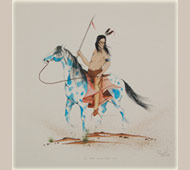 Jonny Hawk is a Creek/Seminole Indian from Oklahoma. He attended Oklahoma State University and has painted as a career. He paints with acrylic paints and often uses watercolors. He has won numerous awards during his career, including recognition at the Cherokee National Museum, Five Civilized Tribes Museum, All-Oklahoma Indian Artists Invitational, The Philbrook Museum of Art, Gallup Inter-tribal Indian Ceremonials, and the Heard Museum, as well as other venues, including having participated in the Franco-American Institute Exhibition in France.
Jonny Hawk is a Creek/Seminole Indian from Oklahoma. He attended Oklahoma State University and has painted as a career. He paints with acrylic paints and often uses watercolors. He has won numerous awards during his career, including recognition at the Cherokee National Museum, Five Civilized Tribes Museum, All-Oklahoma Indian Artists Invitational, The Philbrook Museum of Art, Gallup Inter-tribal Indian Ceremonials, and the Heard Museum, as well as other venues, including having participated in the Franco-American Institute Exhibition in France.
The Indian on his horse is checking out footprints of an animal he must be following. The Indian is dressed in buckskin pants, moccasins and has a blanket wrapped around his waist. He is shirtless. The spear in his hand indicates he is seriously looking for the animal whose track he is following.
The painting is signed in lower right Scott 72 and is triple-matted with acid-free mat material and framed in a wood frame.
Condition: original condition
Provenance: from the collection of a gentleman in California
Subject: Original Painting "When We've Met"
Artist: Johnson Lee Scott (1934-) Jonny Hawk
Category: Paintings
Origin: Creek Nation
Medium: casein on board
Size: 12" x 12" image; 22-1/2" x 22-1/2" framed
Item # C3381B
Subject: Original Painting of Zuni Shalako Ceremony
Fred Cleveland is a member of the Bitter Water and Kayonnie clans. He was born in a hogan on the Navajo Reservation near Ganado, Arizona where his family raised sheep. He was first exposed to art when he watched his mother weave rugs and his father, who created images in the curative process of sand painting. He left the reservation for a time when his mother taught weaving at Arizona State College in Flagstaff. She could not afford a babysitter and as he sat close by her in the classroom, students would pass him pencils and paper to work with and keep him busy. This was his introduction to a means of expression that he has used ever since. At Toyei Boarding School in Arizona he painted a mural, and during his army experience in Germany did murals as part of his KP duty.
Cleveland remained a basically self-taught artist until he and three other Native American artists, Ted Draper, Jimmy Abeita, and Sammy Sandoval, went away to study for a year and a half at the American Academy of Art in Chicago. He has continued to paint Native American subjects of his tribe as well as other tribes whom he has visited.
This painting of the Zuni Pueblo Shalako ceremony is probably based on Cleveland having witnessed this all-night event at some point. The Zuni Shalako Ceremony is open to the public, particularly those who have the stamina to stay up all night in sub-zero weather. The painting is signed in lower right. It is not dated. A simple black metal frame forms an outline for the painting.
Condition: original condition
Provenance: from the collection of a gentleman in California
Subject: Original Painting of Zuni Shalako Ceremony
Artist: Fred Cleveland
Category: Paintings
Origin: Diné - Navajo Nation
Medium: acrylic on canvas
Size: 35-1/2" x 23-1/2" image; 36" x 24" framed
Item # C3381A
Subject: Acoma Pueblo Polychrome Olla, circa 1930s
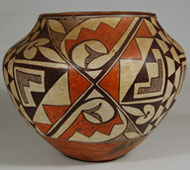 Pottery has always been a central feature of the pueblo people, both for ceremonial and utilitarian purposes. Everything about the daily lives of the pueblo people is of a religious nature. They do not look at jars such as this one as an "art object" as we do. To them, it is a utilitarian vessel or in some cases a ceremonial vessel. The fact that it is beautifully decorated is accepted as part of their history and their lives. Pottery is a sacred part of daily life. It is a gift from Mother Earth to the pueblo people.
Pottery has always been a central feature of the pueblo people, both for ceremonial and utilitarian purposes. Everything about the daily lives of the pueblo people is of a religious nature. They do not look at jars such as this one as an "art object" as we do. To them, it is a utilitarian vessel or in some cases a ceremonial vessel. The fact that it is beautifully decorated is accepted as part of their history and their lives. Pottery is a sacred part of daily life. It is a gift from Mother Earth to the pueblo people.
Whether a jar was made for use by the potter in her home or whether it was made for sale to a tourist visiting the pueblo is of no consequence. What are important to collectors are age, condition and beauty. Also important to Acoma potters is that potsherds of prehistoric or historic or even contemporary pottery are ground up and added to the clay for making a new pot. Every Acoma pot contains some part of an older pot. This provides a continuum to the two thousand year history of Acoma pottery.
This wonderful jar is full of beautiful traditional Acoma Pueblo designs. The potter certainly did not skimp on design when producing this one. The jar was divided into three large diamonds that expand from rim to lower framing line and from diamond to diamond. Each of the three was bisected by black triangles placed in a vertical position. It was then that the mastery of the potter began to excel. The triangles formed by the two diamonds touching at mid body feature spirals with fine line and orange elements. The diamond sections feature fine line element and black and orange triangles.
The jar is full of design and each element compliments the other elements. The designer of this jar was a master artist and an exquisite painter. The jar is magnificent.
Condition: The jar is in excellent condition for a vessel of its age.
Provenance: from the estate of Reggie Sawyer, the Hanging Tree Gallery, Albuquerque
Recommended Reading: The Pottery of Acoma Pueblo by Lanmon and Harlow
Subject: Acoma Pueblo Polychrome Olla, circa 1930s
Potter Unknown
Category: Historic
Origin: Acoma Pueblo
Medium: clay, pigment
Size: 9-1/2" tall x 11-1/2" diameter
Item # C3385A
Subject: Laguna Pueblo Polychrome Pottery Olla
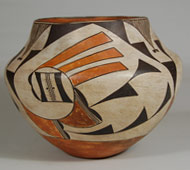 It is quite often difficult to distinguish whether a pottery jar is from Acoma or Laguna Pueblo. Refugees from Acoma and other pueblos established Laguna Pueblo a few years after the Pueblo Revolt of 1680. As a result, its pottery is very similar to that of Acoma Pueblo, and, for the most part, is indistinguishable from Acoma ceramics. Sometimes, designs can be a distinguishing factor.
It is quite often difficult to distinguish whether a pottery jar is from Acoma or Laguna Pueblo. Refugees from Acoma and other pueblos established Laguna Pueblo a few years after the Pueblo Revolt of 1680. As a result, its pottery is very similar to that of Acoma Pueblo, and, for the most part, is indistinguishable from Acoma ceramics. Sometimes, designs can be a distinguishing factor.
The black and white squares inside the spiral curve of this jar are often seen on Laguna jars. Sometimes they are split rectangles. In this case, they are split by three parallel lines outlined by dots on the outer lines. The double black dots (that look similar to sunglasses) extended from the fine line triangles on the body design are almost always associated with pottery from Laguna. Lastly, the openness and simplicity of the design is more a characteristic of Laguna than Acoma wares.
Using one's imagination, it is easy to see that the design is a stylized bird element. The curved line is the head of the bird, the black and white square represents the eyes, the three parallel orange bars are head feathers and, finally, the curved triangles below are either body feathers or perhaps clouds over which the bird is flying. There are three of these designs around the jar.
The jar has an orange color underbody and a two-inch wide orange band inside the neck. There is a black rim without a ceremonial line break, but, looking carefully at the framing line below the rim, one sees a ceremonial break in the triangle element comprised of parallel fine lines.
Condition: very good condition
Provenance: from the estate of Reggie Sawyer, the Hanging Tree Gallery, Albuquerque
Recommended Reading: Acoma & Laguna Pottery by Rick Dillingham (1952-1994)
Subject: Laguna Pueblo Polychrome Pottery Olla
Potter Unknown
Category: Historic
Origin: Laguna Pueblo
Medium: clay, pigment
Size: 8-1/4" tall x 10-5/8" diameter
Item # C3385C
Subject: Tewa Koosa Female Clown
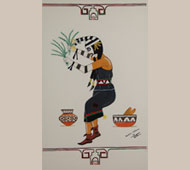 Geraldine's mother, Helen Atencio, was from San Ildefonso Pueblo and her father, Frank Gutierrez, from Santa Clara Pueblo. Although she technically belongs to her mother's pueblo, she makes her residence at Santa Clara and produces blackware pottery as well as paintings. Her paintings are certainly influenced by the work of her uncle, Gilbert Atencio of San Ildefonso Pueblo.
Geraldine's mother, Helen Atencio, was from San Ildefonso Pueblo and her father, Frank Gutierrez, from Santa Clara Pueblo. Although she technically belongs to her mother's pueblo, she makes her residence at Santa Clara and produces blackware pottery as well as paintings. Her paintings are certainly influenced by the work of her uncle, Gilbert Atencio of San Ildefonso Pueblo.
Geraldine Gutierrez carries on in the traditional manner of San Ildefonso Pueblo painting. Dance figures are her favorite theme, and generally they are drawn without any ground lines. Her colors are so intense they look as though they came directly from the paint tubes. They are delicate in value, consistently neat, outlines tend to be fine, and there is much delicate modeling and shading.
Religion is an integral part of Native life and it is incorporated into everyday activities, unlike other religions that are practiced only once a week. The Indians innate ability to sense the harmony of nature and to perceive its beauty as a religious phenomenon that pervades all phases of daily life is often portrayed in their art, as in this painting where Geraldine portrays a Tewa Clown (Koosa) performing a ceremonial offering or daily prayers with evergreen boughs in her hands. This Koosa is dressed as a female even though the impersonation is being performed by a male.
This painting was completed when the artist was only 14 years of age. The perspective is accurate and the detail is well rendered. The face of the clown is remarkably well drawn.
Condition: appears to be in original condition
Provenance: from the personal collection of Margaret Gutierrez of Santa Clara Pueblo
Subject: Tewa Koosa Female Clown
Artist: Geraldine Gutierrez (1960 - present)
Category: Paintings
Origin: Santa Clara Pueblo
Medium: watercolor on paper
Size: 15-1/2" x 9-3/4" image; 24" x 18-1/4" framed
Item # C3372C
Subject: Hopi Polychrome Seed Jar with Bird Design
This visually charming Hopi-Tewa jar demonstrates in style and technique all the hallmarks of a circa 1920s product. The shape is derived from the bulbous shouldered saucer shaped jars common to the prehistoric Sikyatki pottery tradition of the 15th and 16th centuries. The vessel has a conical up-thrusting neck gracefully projecting from the jar's body without seam or flexure.
The design composition is perfectly complementary to the sculptural form of the vessel. The heavy unbroken black encircling upper body band separates the neck of the jar from its mid body. Interestingly, a thin black framing line just below the wide framing line of the neck does feature a ceremonial line break. The framing line at the mid body does not have a ceremonial line break.
The avian designs and geometric elements point to the aesthetic of an outstanding potter and painter, whose identity will remain a mystery.
The jar was fired in a coal-burning atmosphere, contributing the ivory toned color to the jar's surface and the polished inner lip of the rim. Such jars were featured prominently at the Fred Harvey Hopi House at the Grand Canyon.
Condition: very good condition
Provenance: from the collection of Dr. Allan Cooke, co-author of the book Canvas of Clay: Seven Centuries of Hopi Ceramic Art who purchased it from Santa Fe dealer and collector Richard M. Howard in 1997.
Recommended Reading: Canvas of Clay: Seven Centuries of Hopi Ceramic Art by Edwin L. Wade and Allan R. Cooke
Subject: Hopi Polychrome Seed Jar with Bird Design
Potter Unknown
Category: Historic
Origin: Hopi Pueblo
Medium: clay, pigment
Size: 4-1/2" tall x 8-1/2" diameter
Item # C3384C
Subject: Polacca Polychrome Double Chamber Pottery Box
It has remained a mystery as to the use of these rectangular pottery boxes but it is generally thought there might have been a ceremonial purpose, perhaps for use in kiva ceremonies. The jar has been identified to circa 1880 by Francis Harlow.
The two chambers of the box are divided by a wall so each chamber serves an independent purpose. On one side of the wall of the vessel, a red rim coordinates with a red wall design while a black rim coordinates with a black wall design. On the opposite side of the vessel, a red rim coordinates with a black design and a black rim coordinates with a red design. The designs on the ends of the vessel are the same. Six black dots rest on the shoulder of the box and each of the wall designs has black dots capping the triangular design.
Condition: excellent condition.
Provenance: published in the book Modern Pueblo Pottery by Francis Harlow, p 93. Harlow sold the box to pottery collector Larry Frank who eventually sold it in 2000 to Dr. Allan Cooke, co-author of the book Canvas of Clay: Seven Centuries of Hopi Ceramic Art, from whose collection it is now available.
Recommended Reading: Canvas of Clay: Seven Centuries of Hopi Ceramic Art by Edwin L. Wade and Allan R. Cooke
Subject: Polacca Polychrome Double Chamber Pottery Box
Potter Unknown
Category: Historic
Origin: Hopi Pueblo
Medium: clay, pigment
Size: 6-1/4" x 3-1/8" x 3-7/8" high
Item # C3384B
Subject: Hopi Polychrome Small Storage Jar
This wonderful Hopi polychrome small storage jar was probably made in the first half of the 20th century and could have been made by a member of the Nampeyo family, although not by Nampeyo. At that time, Nampeyo had failing eyesight and would not have been able to apply the decoration, even if she had made the jar. One of her daughters or some other Nampeyo family member certainly could have made it but we cannot be more definitive than that.
There are three storage jars of similar vessel shape in the book "The Legacy of a Master Potter: Nampeyo and Her Descendants" and that is our source for attributing the maker as a member of the Nampeyo family although the individual must remain unidentified.
The jar is magnificent, both in size, construction, and design. The jar has been divided into four design panels, each outlined by three vertical black lines. Within each panel, there are additional divisions into quarters. Each quarter features a variety of designs, mostly geometrics. There is a wide framing line near the base of the jar and another one at the neck, neither of which has a ceremonial line break. Stippling, used by many members of the Nampeyo family, appears in each design panel.
The base of the jar is somewhat rounded, as is typical of jars that were made for actual use as they would be snuggled into a dirt floor. Jars made for sale to collectors or tourists normally have a flat base. The rim of the jar has an exaggerated flair outward similar to jars at Zuni Pueblo made for use as drums. Overall, the jar has a beautiful warm glow to the yellow/orange slip.
Condition: the jar is in excellent condition
Provenance: from the collection of Dr. Allan Cooke, co-author of the book Canvas of Clay: Seven Centuries of Hopi Ceramic Art.
Recommended Reading: Canvas of Clay: Seven Centuries of Hopi Ceramic Art by Edwin L. Wade and Allan R. Cooke
Subject: Hopi Polychrome Small Storage Jar
Potter Unknown
Category: Contemporary
Origin: Hopi Pueblo
Medium: clay, pigment
Size: 9-1/2" tall x 11-1/4" diameter
Item # C3384E
Subject: Hopi White-slipped Wedding Vessel
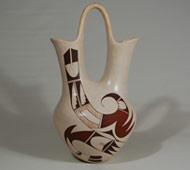 Joy Navasie is among the most famous of Hopi-Tewa potters. She learned the skill from her famous mother, Paqua Naha, the first Frog Woman. Paqua developed white-ware pottery in the mid-1950s and Joy continued the tradition until she ceased potting around 2000 due to health reasons. She passed away in 2012.
Joy Navasie is among the most famous of Hopi-Tewa potters. She learned the skill from her famous mother, Paqua Naha, the first Frog Woman. Paqua developed white-ware pottery in the mid-1950s and Joy continued the tradition until she ceased potting around 2000 due to health reasons. She passed away in 2012.
This very large wedding vessel is typical of her graceful style. It has long curving necks connected by a tall arched handle. Joy's use of one large uncluttered design on each side adds to the cleanliness and elegance of the vessel. The parrot design features the beak on the body of the vessel and a wing curving upward on one spout. The other spout is without decoration.
Condition: excellent condition
Provenance: from the collection of Dr. Allan Cooke, co-author of the book Canvas of Clay: Seven Centuries of Hopi Ceramic Art. The jar was purchased by Dr. Cooke from a family from Detroit who had purchased it in 1960.
Recommended Reading: Canvas of Clay: Seven Centuries of Hopi Ceramic Art by Edwin L. Wade and Allan Cooke
Subject: Hopi White-slipped Wedding Vessel
Artist: Joy Navasie (1919 - 2012) Frog Woman
Category: Contemporary
Origin: Hopi Pueblo
Medium: clay, pigment
Size: 12-1/2" tall x 7" wide
Item # C3384D
Subject: Hopi Polychrome High-shoulder Seed Jar
Jean is a daughter of Priscilla Namingha Nampeyo and the granddaughter of Rachel Namingha Nampeyo. Her great grandmother was Annie Healing Nampeyo, whose mother was Nampeyo of Hano. Jean has seven siblings, all of whom are potters or Katsina doll carvers. Her brothers and sisters are Nyla Sahmie, Rachel Sahmie, Bonnie Chapella, Randy Sahmie, Andrew Sahmie, Foster Sahmie and Finkle Sahmie. Jean is the only member of the family who signs her name Sahme rather than Sahmie.
Jean Sahme has certainly inherited the artistic talent from her famous Nampeyo family. In this jar, she chose to use the Sikyatki migration pattern design but modified it to a contemporary style of her choosing. The interlocking hooked pattern is of the Sikyatki tradition, but the squiggly lines in the brown paint are of her fertile mind. She also attached eagle tail feather elements to the lower hook elements. To provide room for this expanded design, she made the jar tall with a high shoulder.
The application of the design was precise with curves and straight lines unimaginably rendered. One has to marvel at the talent required to apply such a design using a primitive paint brush made from the leaf of a yucca plant and paints from mineral sources. The outdoor firing produced a fire cloud on the lower body of the jar below the design panel. It adds such interesting warmth to the jar.
Condition: original condition
Provenance: from the collection of Dr. Allan Cooke, co-author of the book Canvas of Clay: Seven Centuries of Hopi Ceramic Art. The jar was purchased by Dr. Cooke in 1991.
Recommended Reading: Canvas of Clay: Seven Centuries of Hopi Ceramic Art by Edwin L. Wade and Allan Cooke
Subject: Hopi Polychrome High-shoulder Seed Jar
Artist: Jean Sahme Nampeyo (1948 - present)
Category: Contemporary
Origin: Hopi Pueblo
Medium: clay, pigment
Size: 6-5/8" tall x 8-1/4" diameter
Item # C3384A
Subject: Original Quincy Tahoma Painting "Fire Dance"
![Original Quincy Tahoma Painting “Fire Dance” When the Japanese attacked Pearl Harbor in December 1941, Native American young men hastened to volunteer to serve their country. The numbers of Navajo servicemen and women represented one of the largest percent of any ethnic groups in the U. S. to serve. The entire football team of the Santa Fe Indian School marched together to enlist after their homecoming game. The Selective Service stated that 99 percent of all eligible Indians had registered for the draft, a much larger percentage than non-Indians. Quincy Tahoma, claiming he was 21, when actually he was 24, registered to serve but was declared 4F Status because of a deformed arm. Left behind when all his friends had departed Santa Fe, Tahoma full heartedly dove into pursuing his art career. Photographer T. Harmon Parkhurst had a photography studio in the plaza area and invited Tahoma to paint and display his art at the studio. The New Mexico Museum of Art frequently exhibited paintings by Native artists. Tahoma benefited from both these venues. In this paining, Tahoma illustrates a portion of the Navajo Fire Dance, a dance at the end of the nine-day Mountain Chant. To start the dance, many young men drag great trees for a central fire, which rapidly turns into a fierce flaring, crackling, and roaring heat. When it becomes its hottest, suddenly the loud burring call of the fire-dancers fills the air. The following is a description of the Fire Dance as witnessed in the 19th century by Washington Matthews. "The men, racing in a circle round the fire, close to the unbearable heat, whooped like demons and beat their own bodies and each other's with the flaming brands. One man beat the bare back in front of him until it slipped away. Then he flared his brand over his own back, showering sparks, he straddled it as he ran, he turned and threw its flames over the man who followed him. They washed each other's backs with flame. They leaped so close to the fire that their bare feet seemed to be treading on live coals. The figures, following each his own devices, together made a painting such as Doré might have done for Dante's Inferno: pale inhuman figures, capering in the firelight, bathed in the red glow and the showers of orange sparks, always calling that queer suggestion of flickering flame. It seemed to last a long time; actually until the cedar brands were well burned out. Then each man dropped his smoldering bark and, still trilling loudly, ran out of the corral. Intense, brilliant, savage. "As the dancers left, spectators swarmed in to pick up bits of the burned cedar, sure protection against danger of fire for the year to come. By this time the east was showing white, that comfortless early morning light which makes everyone ghastly. Even brown Navajo faces looked gray. White people appeared as at the end of a long illness or a terrific debauch. The fire was burning low again, but nobody built it up. Then the chief medicine-man came in. He had not been seen all night, his task having been to sit in the hogan, chanting. Now he entered, accompanied by his assistants, and chanted while they scattered water on the fire at the four ceremonial points. Then young men tore gaps in the circle of branches, one opening toward each direction. As the medicine-man went back to the hogan, they demolished the whole corral, leaving the branches on the ground. Day was full by that time, and the circle of prostrate branches was like a stage with all the scenery removed and the curtains rolled up. The only important matter seemed breakfast, especially coffee." Tahoma illustrates the Fire Dance with only two participants but as many as 14 may participate. This painting is signed and dated 1942. On verso, is written in pencil: Navajo Fire Dance, Quincy Tahoma, Indian School, Santa Fe, NM. Condition: appears to be in original condition but has not been examined out of the frame. It appears to be the original framing. Provenance: from the estate of a Salt Lake City family Recommended Reading: Quincy Tahoma, The Life and Legacy of a Navajo Artist [SOLD] by Charnell Havens, et. al.](https://www.adobegallery.com/uploads/C3386-thumb.jpg) When the Japanese attacked Pearl Harbor in December 1941, Native American young men hastened to volunteer to serve their country. The numbers of Navajo servicemen and women represented one of the largest percent of any ethnic groups in the U. S. to serve. The entire football team of the Santa Fe Indian School marched together to enlist after their homecoming game. The Selective Service stated that 99 percent of all eligible Indians had registered for the draft, a much larger percentage than non-Indians. Quincy Tahoma, claiming he was 21, when actually he was 24, registered to serve but was declared 4F Status because of a deformed arm.
When the Japanese attacked Pearl Harbor in December 1941, Native American young men hastened to volunteer to serve their country. The numbers of Navajo servicemen and women represented one of the largest percent of any ethnic groups in the U. S. to serve. The entire football team of the Santa Fe Indian School marched together to enlist after their homecoming game. The Selective Service stated that 99 percent of all eligible Indians had registered for the draft, a much larger percentage than non-Indians. Quincy Tahoma, claiming he was 21, when actually he was 24, registered to serve but was declared 4F Status because of a deformed arm.
Left behind when all his friends had departed Santa Fe, Quincy Tahoma full heartedly dove into pursuing his art career. Photographer T. Harmon Parkhurst had a photography studio in the plaza area and invited Tahoma to paint and display his art at the studio. The New Mexico Museum of Art frequently exhibited paintings by Native artists. Tahoma benefited from both these venues.
In this paining, Tahoma illustrates a portion of the Navajo Fire Dance, a dance at the end of the nine-day Mountain Chant. To start the dance, many young men drag great trees for a central fire, which rapidly turns into a fierce flaring, crackling, and roaring heat. When it becomes its hottest, suddenly the loud burring call of the fire-dancers fills the air. The following is a description of the Fire Dance as witnessed in the 19th century by Washington Matthews.
"The men, racing in a circle round the fire, close to the unbearable heat, whooped like demons and beat their own bodies and each other's with the flaming brands. One man beat the bare back in front of him until it slipped away. Then he flared his brand over his own back, showering sparks, he straddled it as he ran, he turned and threw its flames over the man who followed him. They washed each other's backs with flame. They leaped so close to the fire that their bare feet seemed to be treading on live coals. The figures, following each his own devices, together made a painting such as Doré might have done for Dante's Inferno: pale inhuman figures, capering in the firelight, bathed in the red glow and the showers of orange sparks, always calling that queer suggestion of flickering flame. It seemed to last a long time; actually until the cedar brands were well burned out. Then each man dropped his smoldering bark and, still trilling loudly, ran out of the corral. Intense, brilliant, savage.
"As the dancers left, spectators swarmed in to pick up bits of the burned cedar, sure protection against danger of fire for the year to come. By this time the east was showing white, that comfortless early morning light which makes everyone ghastly. Even brown Navajo faces looked gray. White people appeared as at the end of a long illness or a terrific debauch. The fire was burning low again, but nobody built it up. Then the chief medicine-man came in. He had not been seen all night, his task having been to sit in the hogan, chanting. Now he entered, accompanied by his assistants, and chanted while they scattered water on the fire at the four ceremonial points. Then young men tore gaps in the circle of branches, one opening toward each direction. As the medicine-man went back to the hogan, they demolished the whole corral, leaving the branches on the ground. Day was full by that time, and the circle of prostrate branches was like a stage with all the scenery removed and the curtains rolled up. The only important matter seemed breakfast, especially coffee."
Tahoma illustrates the Fire Dance with only two participants but as many as 14 may participate. This painting is signed and dated 1942. On verso, is written in pencil: Navajo Fire Dance, Quincy Tahoma, Indian School, Santa Fe, NM.
Condition: appears to be in original condition but has not been examined out of the frame. It appears to be the original framing.
Provenance: from the estate of a Salt Lake City family
Recommended Reading: Quincy Tahoma, The Life and Legacy of a Navajo Artist by Charnell Havens, et. al.
Subject: Original Quincy Tahoma Painting "Fire Dance"
Artist: Quincy Tahoma 1917-1956 Water Edge
Category: Paintings
Origin: Diné - Navajo Nation
Medium: casein on paper
Size: 18-1/4" x 12-3/4" image; 24-3/4" x 18-7/8" framed
Item # C3386
Subject: Black-on-black San Ildefonso Pueblo Jar signed Marie & Santana
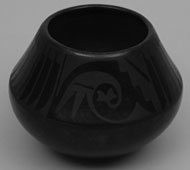 Following the death of Julian in 1943 at the age of 46 years, Maria was devastated as the two had worked together as partners their entire married life. Julian did the hard work of digging clay, crushing the clay and firing the finished pottery. Julian had been a handsome and elegant man. He always dressed in traditional pueblo clothing, wearing shirts made by Maria. He never wore commercial clothing. The couple was the epitome of traditional pueblo Indians.
Following the death of Julian in 1943 at the age of 46 years, Maria was devastated as the two had worked together as partners their entire married life. Julian did the hard work of digging clay, crushing the clay and firing the finished pottery. Julian had been a handsome and elegant man. He always dressed in traditional pueblo clothing, wearing shirts made by Maria. He never wore commercial clothing. The couple was the epitome of traditional pueblo Indians.
Adam, Maria's and Julian's oldest son took over the responsibilities of his dad and helped his mom with the heavy work of pottery production. Adam's wife, Santana, also began helping Maria at that time. Maria would make the pottery and Santana would do the painting. These early pottery were signed Marie & Santana and this signature continued from 1943 until 1956. Their cooperative efforts continued but around 1956, the signature changed to Maria & Santana-an indication that Maria finally decided to use her real name Maria and not Marie that she had been using previously. This occurred following the publication of the book Maria, the Potter of San Ildefonso by Alice Marriot.
This jar dates to probably 1956, at the end of the Marie & Santana signature period. It has the feather design and a spiral element resembling the Avanyu design.
Condition: structurally in fine condition.
Provenance: from the estate of Mr. & Mrs. Jackson Clark Gillis of Tarzana, California. The jar was mailed to the Gillis' in February 1957 from Saddle Rock Arts and Crafts of Sedona, Arizona at a price of $23.50. The letter from Saddle Rock accompanies the purchase of the jar.
Recommended Reading: The Legacy of Maria Poveka Martinez by Richard Spivey
Subject: Black-on-black San Ildefonso Pueblo Jar signed Marie & Santana
Artist / Potter: Maria Martinez 1887-1980
Category: Contemporary
Origin: San Ildefonso Pueblo
Medium: native clay
Size: 4-1/2" tall x 6-1/8" diameter
Item # C3313D


